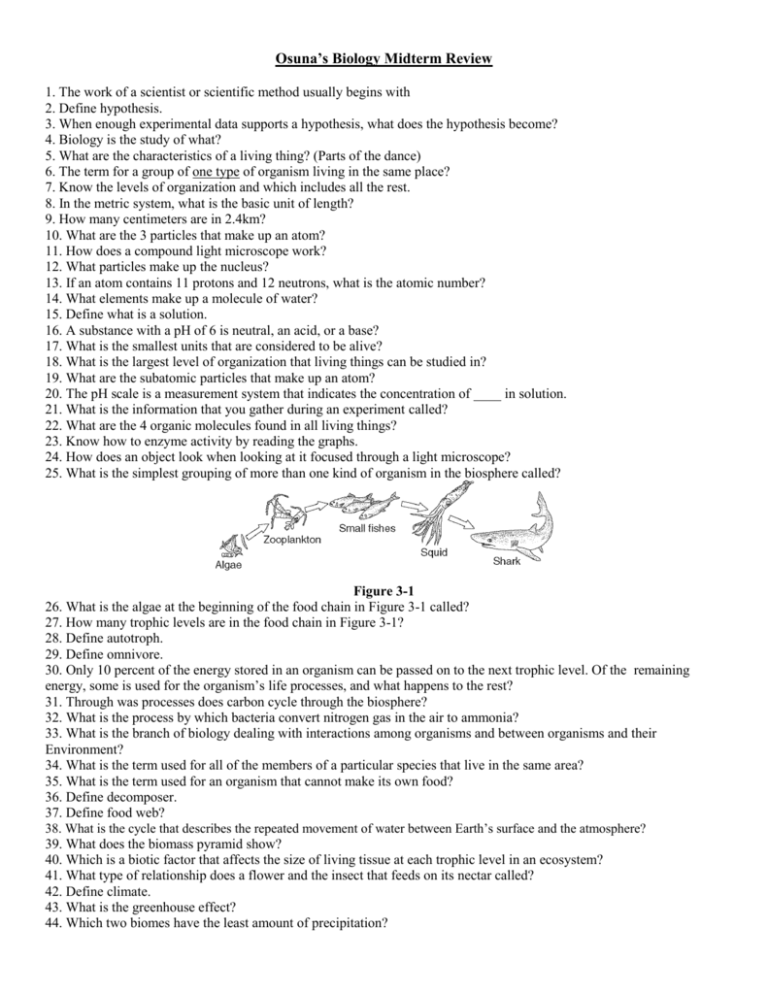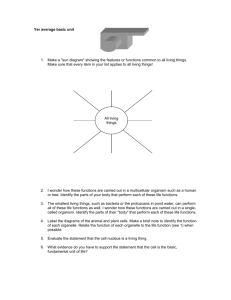Osuna's Biology Midterm Review
advertisement

Osuna’s Biology Midterm Review 1. The work of a scientist or scientific method usually begins with 2. Define hypothesis. 3. When enough experimental data supports a hypothesis, what does the hypothesis become? 4. Biology is the study of what? 5. What are the characteristics of a living thing? (Parts of the dance) 6. The term for a group of one type of organism living in the same place? 7. Know the levels of organization and which includes all the rest. 8. In the metric system, what is the basic unit of length? 9. How many centimeters are in 2.4km? 10. What are the 3 particles that make up an atom? 11. How does a compound light microscope work? 12. What particles make up the nucleus? 13. If an atom contains 11 protons and 12 neutrons, what is the atomic number? 14. What elements make up a molecule of water? 15. Define what is a solution. 16. A substance with a pH of 6 is neutral, an acid, or a base? 17. What is the smallest units that are considered to be alive? 18. What is the largest level of organization that living things can be studied in? 19. What are the subatomic particles that make up an atom? 20. The pH scale is a measurement system that indicates the concentration of ____ in solution. 21. What is the information that you gather during an experiment called? 22. What are the 4 organic molecules found in all living things? 23. Know how to enzyme activity by reading the graphs. 24. How does an object look when looking at it focused through a light microscope? 25. What is the simplest grouping of more than one kind of organism in the biosphere called? Figure 3-1 26. What is the algae at the beginning of the food chain in Figure 3-1 called? 27. How many trophic levels are in the food chain in Figure 3-1? 28. Define autotroph. 29. Define omnivore. 30. Only 10 percent of the energy stored in an organism can be passed on to the next trophic level. Of the remaining energy, some is used for the organism’s life processes, and what happens to the rest? 31. Through was processes does carbon cycle through the biosphere? 32. What is the process by which bacteria convert nitrogen gas in the air to ammonia? 33. What is the branch of biology dealing with interactions among organisms and between organisms and their Environment? 34. What is the term used for all of the members of a particular species that live in the same area? 35. What is the term used for an organism that cannot make its own food? 36. Define decomposer. 37. Define food web? 38. What is the cycle that describes the repeated movement of water between Earth’s surface and the atmosphere? 39. What does the biomass pyramid show? 40. Which is a biotic factor that affects the size of living tissue at each trophic level in an ecosystem? 41. What type of relationship does a flower and the insect that feeds on its nectar called? 42. Define climate. 43. What is the greenhouse effect? 44. Which two biomes have the least amount of precipitation? 45. Which biome is characterized by very low temperature, little precipitation, and permafrost? 46. Know what are some abiotic factors and what aren’t abiotic factors. 47. Define niche. 48. Term for interaction in which organism captures and feeds on another organism. 49. Ponds and lakes are what type of water ecosystem? 50. Define emigration vs immigration. 51. What happens to population growth if resources in a population begin to become less available? 52. How is population growing in a country like India? What term do we use? 53. What was DDT used for? 54. What is the term used for when a species disappears from all or part of its environment? 55. Define pioneer species. 56. What type of succession is there when there is a wild fire and the community rebuilds itself? 57. What is the basic life unit of life? 58. Biology divides cells into which two categories? 59. Who was the first scientist to look at a slide of cork and actually name the cell? 60. What is stated in the cell theory? 61. What do all eukaryotic cells contain? 62. What organelle contains a cell’s genetic material & considered the “brain”? 63. What organelle is considered the “powerhouse” of the cell & where ATP is made? 64. What structure provides support, protection, and regulates what enters and leaves the cell? 65. Define osmosis. 66-68. When looking at a diagram understand whether water is coming into the cell, leaving the same, or both. Then state whether the cell is hypertonic, hypotonic, or isotonic. 69. What pigment found in the chloroplast, allows plats to absorb light energy? 70. 6 CO2 + 6 H2O ______________ + ___________ 71. Whats is C6H12O 6 ? 72. Which process uses light energy to make ATP, NADH, and oxygen? 73. What is the stroma? 74. What is the final product of the Calvin Cycle? 75. Cheetos have 230 Calories in a single serving. How many calories is that equal to? 76. How many phosphates are in one ADP (adenosine di-phosphate) molecule? 77. How many phosphate groups are in one ATP (adenosine tri-phosphate) molecule? 78. What is the equation for cellular respiration? 79. What is an aerobic process? 80. Glycolysis is the process that breaks down one glucose into two molecules of what? 81. How many ATP are formed at the end of cellular respiration? 82. The high-energy electrons from the Kreb’s cycle converts what into what? 83. The Kreb’s Cycle and the Electron Transport Chain occur in what organelle? 84. What does Lactic Acid Fermentation occur? 85. The cell cycle begins with one cell and produces how many cells? 86. What are the cells produced at the end of the cell cycle called? 87. What is the phase that cells spend about 75% of their life in and prepares the cells for division? 88. In what stage does the cell’s DNA get replicated & synthesized? 89. What are the 4 stages of Mitosis? 90. In what stage of mitosis do chromosomes line up in the middle or equator of the cell? 91. What is the division of the cytoplasm and the entire cell called? 92. What disorder is associated with the unregulated mitosis and structures called tumors? 93. Why is Meiosis known as a reduction division? 94. What is the diploid number of chromosomes in a human cell? 95. What is crossing-over & when does it occur? 96. How many cells are produced after Meiosis II? 97. How many chromosomes are in the cells at the end of Meiosis II? (Happloid or Diploid?) 98. What term describes when the male and female gametes merge? 99. Why is it that males produce so many more sperm than females produce eggs? 100. What are the 3 major differences between Mitosis and Meiosis?







